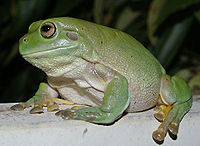
Purification and cDNA Cloning of Antimicrobial Peptides from the Skin Secretion of the Chinese Frog Rana chensinensis
Sign Up to like & getrecommendations! Published in 2020 at "International Journal of Peptide Research and Therapeutics"
DOI: 10.1007/s10989-020-10074-y
Abstract: The skin secretions of amphibians are a rich source of bioactive peptides. We isolated chensirin-1 and chensirin-2 from the skin secretion of the Chinese frog Rana chensinensis . Sephadex-G-50 and RP-HPLC were employed to purify… read more here.
Keywords: secretion chinese; rana chensinensis; frog rana; chinese frog ... See more keywords

Skin secretion transcriptome remains in chromatographic fractions suitable for molecular cloning.
Sign Up to like & getrecommendations! Published in 2019 at "Analytical biochemistry"
DOI: 10.1016/j.ab.2018.10.006
Abstract: Traditional sources of mRNA for molecular cloning on amphibian skin secretion studies have been the frog's skin and skin secretions. Here, we demonstrate that mRNA isolated from chromatographic fractions of skin secretions is amenable for… read more here.
Keywords: molecular cloning; chromatographic fractions; transcriptome remains; secretion transcriptome ... See more keywords

A hemostatic sponge derived from skin secretion of Andrias davidianus and nanocellulose
Sign Up to like & getrecommendations! Published in 2021 at "Chemical Engineering Journal"
DOI: 10.1016/j.cej.2021.129136
Abstract: Abstract Excessive blood loss is one of the leading causes of death in trauma, and developing injectable and antibacterial shape-memory hemostatic materials with high blood absorption ratio and fast shape recovery for noncompressible torso hemorrhage… read more here.
Keywords: blood; andrias davidianus; sponge; secretion andrias ... See more keywords

Discovery of Novel Caeridins from the Skin Secretion of the Australian White's Tree Frog, Litoria caerulea
Sign Up to like & getrecommendations! Published in 2018 at "International Journal of Genomics"
DOI: 10.1155/2018/8158453
Abstract: Abundant biologically active peptides have been discovered from frog skin secretions, a rich natural source of bioactive compounds with great potential in drug discovery. In this study, three Caeridin peptides, namely, Caeridin-1, S5-Caeridin-1, and Caeridin-a1,… read more here.
Keywords: frog litoria; australian white; tree frog; white tree ... See more keywords

Discovery of Distinctin-Like-Peptide-PH (DLP-PH) From the Skin Secretion of Phyllomedusa hypochondrialis, a Prototype of a Novel Family of Antimicrobial Peptide
Sign Up to like & getrecommendations! Published in 2018 at "Frontiers in Microbiology"
DOI: 10.3389/fmicb.2018.00541
Abstract: Amphibian skin secretions are an important treasure house of bioactive antimicrobial peptides (AMPs). Despite having been the focus of decades of research in this context, investigations of phyllomedusine frogs continue to identify new AMPs from… read more here.
Keywords: peptide; novel family; prototype novel; dlp ... See more keywords

Identification and Rational Design of a Novel Antibacterial Peptide Dermaseptin-AC from the Skin Secretion of the Red-Eyed Tree Frog Agalychnis callidryas
Sign Up to like & getrecommendations! Published in 2020 at "Antibiotics"
DOI: 10.3390/antibiotics9050243
Abstract: Antibiotic resistance represents a tremendous contemporary clinical challenge. Given this challenge, antimicrobial peptides (AMPs) are regarded as one of the most promising new options for next-generation lead antibiotics. Here, we describe the antibacterial activities of… read more here.
Keywords: peptide; identification rational; rational design; activity ... See more keywords

LFB: A Novel Antimicrobial Brevinin-Like Peptide from the Skin Secretion of the Fujian Large Headed Frog, Limnonectes fujianensi
Sign Up to like & getrecommendations! Published in 2019 at "Biomolecules"
DOI: 10.3390/biom9060242
Abstract: Amphibians are a natural source of abundant antimicrobial peptides and thus have been widely investigated for isolation of such biomolecules. Many new antimicrobial peptide families have been discovered from amphibians. In this study, a novel… read more here.
Keywords: novel antimicrobial; peptide; fujian large; secretion fujian ... See more keywords

Amphibian Skin and Skin Secretion: An Exotic Source of Bioactive Peptides and Its Application
Sign Up to like & getrecommendations! Published in 2023 at "Foods"
DOI: 10.3390/foods12061282
Abstract: Amphibians have been consumed as an alternative protein source all around the world due to their delicacy. The skin of edible amphibians, particularly frogs and giant salamanders, always goes to waste without further utilization. However,… read more here.
Keywords: amphibian skin; skin; bioactive peptides; source ... See more keywords

In Vitro & In Vivo Studies on Identifying and Designing Temporin-1CEh from the Skin Secretion of Rana chensinensis as the Optimised Antibacterial Prototype Drug
Sign Up to like & getrecommendations! Published in 2022 at "Pharmaceutics"
DOI: 10.3390/pharmaceutics14030604
Abstract: Amphibian skin secretion is an ideal source of antimicrobial peptides that are difficult to induce drug resistance to due to their membrane-targeting mechanism as a new treatment scheme. In this study, a natural antimicrobial peptide… read more here.
Keywords: vitro vivo; rana chensinensis; temporin 1ceh; activity ... See more keywords